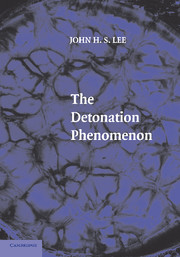Book contents
- Frontmatter
- Contents
- Preface
- 1 INTRODUCTION
- 2 GASDYNAMIC THEORY OF DETONATIONS AND DEFLAGRATIONS
- 3 DYNAMICS OF DETONATION PRODUCTS
- 4 LAMINAR STRUCTURE OF DETONATIONS
- 5 UNSTABLE DETONATIONS: NUMERICAL DESCRIPTION
- 6 UNSTABLE DETONATIONS: EXPERIMENTAL OBSERVATIONS
- 7 INFLUENCE OF BOUNDARY CONDITIONS
- 8 DEFLAGRATION-TO-DETONATION TRANSITION
- 9 DIRECT INITIATION OF DETONATIONS
- Epilogue
- Index
Epilogue
Published online by Cambridge University Press: 06 July 2010
- Frontmatter
- Contents
- Preface
- 1 INTRODUCTION
- 2 GASDYNAMIC THEORY OF DETONATIONS AND DEFLAGRATIONS
- 3 DYNAMICS OF DETONATION PRODUCTS
- 4 LAMINAR STRUCTURE OF DETONATIONS
- 5 UNSTABLE DETONATIONS: NUMERICAL DESCRIPTION
- 6 UNSTABLE DETONATIONS: EXPERIMENTAL OBSERVATIONS
- 7 INFLUENCE OF BOUNDARY CONDITIONS
- 8 DEFLAGRATION-TO-DETONATION TRANSITION
- 9 DIRECT INITIATION OF DETONATIONS
- Epilogue
- Index
Summary
The Chapman–Jouguet (CJ) theory, formulated over a century ago, provides a simple method for determining the detonation velocity using the conservation equations and the equilibrium thermodynamic properties of the reactants and products. The Zeldovich–von Neumann–Döring (ZND) theory for the detonation structure, developed in the 1940s, permits the variation of the state in the reaction zone to be computed by integrating the chemical-kinetic rate equations simultaneously with the flow equations. The CJ criterion, which chooses the minimum velocity (or tangency) solution on the equilibrium Hugoniot curve, had been shown by von Neumann to be invalid for certain explosives that have a temperature overshoot (or intersecting partially reacted Hugoniot curves). For these explosives, the detonation velocity is higher than the CJ value and corresponds to weak detonation solutions on the equilibrium Hugoniot curve. Experimental evidence from the past 50 years has also confirmed that detonations are intrinsically unstable and have a transient three-dimensional structure. This throws further doubt on the general validity of the steady one-dimensional CJ theory. However, in spite of all the lack of support for the CJ theory, the CJ detonation velocity is found to agree remarkably well with experiments. Even for near-limit mixtures where three-dimensional transient effects are significant, the averaged velocity still generally agrees with the CJ value to within 10%.
- Type
- Chapter
- Information
- The Detonation Phenomenon , pp. 373 - 376Publisher: Cambridge University PressPrint publication year: 2008



